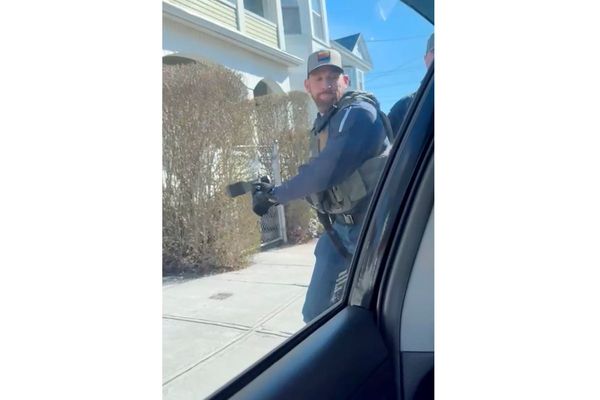
When Chloe Moriondo was born, her mother made her dad go and buy fresh oysters from her favourite restaurant. They were eaten gratefully in the hospital room. Those weird little sea molluscs came back into the 22-year-old alt pop star’s life after a bad breakup. Moriondo kept thinking, sadly, “My world is my oyster,” like if she repeated it enough times she would believe it, and then magically she did. Oyster was the perfect title for her new album about love, loss and turning suffering into beautiful art to present to the world. Its floaty songs are the sort of soft, glitchy pop that I imagine mermaids might make.
We’re facing each other on a Zoom call, both with a plate of oysters in front of us; I’m in London, she’s in her label’s New York office, framed by a backdrop of skyscrapers. An oyster is tossed down her throat elegantly, then she winces: she put too much horseradish on it. “I need to lock in on my ratio,” Moriondo laughs, fluttering her long, fake eyelashes. She styled herself like a freshwater pearl for the interview: in all creamy white with a big scalloped collar top and giant pillowy purse.
Across her eclectic pop output so far, she’s been fond of aquatic imagery. “I grew up in Michigan, which has lakes, not oceans, but I’ve always really loved the water,” she explains. “I was lucky enough to have had a swimming pool in my backyard; my Grandma told me I was going to grow gills one day.” She still lives in Detroit, Michigan, to be close to her mother, friends and creature comforts but is considering a move to New York when her lease ends in August.
Moriondo launched her career on YouTube as a 12-year-old heavily involved in its musical covers scene; she uploaded content at the tail end of a pre-TikTok world when record labels looked to young kids performing cover songs (sometimes with an acoustic guitar or ukulele) like Justin Bieber, Charlie Puth and Halsey, as future stars. In Moriondo’s case, it was the latter, since her small fingers couldn’t stretch to bar chords on guitar. “I did not get much feedback for a very long time,” she smiles of her cover videos. “There was one subscriber I remember who would comment on every video and, to this day, I still see them sometimes in my [Instagram and TikTok] lives, which is crazy because it’s been 10 years.”
Everything changed in 2017 when she posted her first original song, the soft and playful ukulele-accompanied ballad “waves”. It’s reminiscent of Billie Eilish and written about a family holiday she spent dreaming about a girl she had romantic feelings for back at home. At the age of 17, she signed with Elektra/Fueled By Ramen, the home of Paramore, Panic! at the Disco and Fall Out Boy, which was extremely exciting for her as someone who grew up on emo and pop punk; that quirky pop confidence is apparent in her own music. She starts to laugh about how much she loves the first Panic! at the Disco album, A Fever You Can’t Sweat Out: “The burlesque, the weird cabaret situation – it makes me freak out, it’s so cool. The lyrics were so wacky, I don’t know how anyone could come up with that.”
As someone who came of age as a child online, especially as a content creator, Moriondo has reams of images and videos of all her phases for every fan or hater to see – and she admits she’s had many vivid phases. “I’ve had a lot of feelings about the different versions of myself that are permanently online for people to either love or scrutinise. I’ve been embarrassed of my past self a lot because I was cringy – I was a kid. Most kids are cringy; that’s kinda how we start,” she explains. “But now I think I’ve kinda accepted that this is how it works if I want to make things and live off it. I was definitely a little more insecure at points.”

Now, in oyster mode, she’s got a newly girly look, her bottle blonde shoulder-length hair neatly curled up at the ends. “I always felt like I was not like the other girls, but not in an ‘I’m special way’, in an ‘I’m bad’ way’,” she says carefully. “I thought I wasn’t pretty enough. I was definitely less feminine and [more] boyish back then, and now I’m enjoying being feminine and thinking about beautiful art like The Birth of Venus. The ocean in general is a feminine space.”
A few years ago, her fledgling career was in a positive place, off the back of 2021’s pop-punk album Blood Bunny, straight into 2022’s hyper-pop SUCKERPUNCH. Then, suddenly, she pretty much disappeared on the internet. That break was self-imposed: after she got back home to Detroit from the SUCKERPUNCH tour, she experienced a “life-ruining” breakup with her childhood best friend turned girlfriend, Samantha, a visual artist who works under the name Virtual Flesh and namesake and inspiration for Moriondo’s song “Samantha”. They had been in each other’s lives for 10 years, collaborating intensely across Moriondo’s visuals, merch and creative direction.
“I started living alone for the first time – I was feeling depressed, lonely, I wasn’t eating right, I wasn’t sleeping right. I definitely needed time,” she says, temporarily leaving her food to one side. “My manager and entire team could tell at that point without me even saying anything that I needed a break. I took one until I was ready to start writing about what the hell I’d been going through for the past two years.” It took time to process the difficult feelings and listen to the friends who told her she needed to be out of a relationship that had been unhealthy for both parties. “In some ways I still don’t feel super normal. It was very complicated. That’s not an easy thing to let go of,” she says of her ex and former best friend. “Eventually, I kissed some strangers and got over it, at least enough to write some songs.”
Moriondo wallows deeply on piano-led autotuned ballad “pond” and unpacks her nuanced experience of heartbreak on pulsing single “shoreline”. Writing about what happened has been cathartic, she says, adding that even making joke TikTok videos about her pain has been fun. I watch one in which she faints to the floor; the caption overlaid on the screen says: “How i feel when someone requests the love song i named after my ex while i’m promoting the one about our break up”.
It has also been enjoyable to be fully in charge of the visual elements of her work for the first time: she crafted her own Pinterest boards with the more feminine oyster visuals and styling, collaborating with Japanese artist Tetsuhiro Wakabayashi for the album cover. “We had so much creative entanglement,” she says of her ex-partner, who she’s now able to reflect on with positivity. “We worked really well together, and I’m grateful for the time we had together, but it was important for me to do this on my own and learn to be more confident in talking to my team in what I want and like.”
Though plenty of artists over the last few years, from Phoebe Bridgers to Chappell Roan, have taken to criticising their bossy, scary or presumptuous fanbases, Moriondo feels so grateful for hers who have stood by her during this hiatus that she starts welling up. “I started from YouTube – I would be nothing without these people,” she says in tears.
Besides, Moriondo adds, her fans are really polite, shy and sweet – this is where I think: quite like her – the sort to meet her for the first time carrying tiny gifts. “I’m going to be having a lot of oysters this week,” she says, speculating about possible gifts, with a pause to look at her record label-supplied oyster lunch, and a laugh when I express concern that accepting oysters from fans might not be a bright idea. Her fans’ generous behaviour in all guises gives her hope, she says. “They show me that people can just be normal sometimes.”
Will Smith’s resurrected rap career could be a sign of a career in freefall
Mumford & Sons stick to the same format on their latest album, Rushmere
Carlos Santana: ‘Hostile forces tried to destroy Michael Jackson’
Nelly says he felt foolish after ‘miscommunication’ caused Eminem feud
Chris Brown announces tour with special guests and return of fan-favorite feature
Elton John and Brandi Carlile dazzle audience at star-studded London Palladium show







